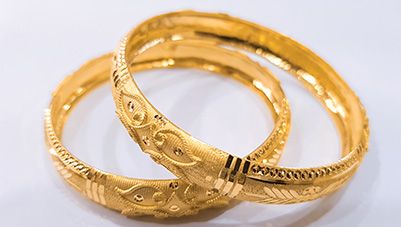Rs. 5,000 - Rs. 2 crore
To find the nearest gold loan branch,
Enter phone and OTP | Check amount you can get | Apply for quick funds
Gold vs platinum price: Key differences in value and usage
Gold and platinum are both valuable metals, but their uses and prices are quite different. Platinum is usually more expensive because it is rarer and in high demand for industrial purposes, though prices can change with market trends. Gold, on the other hand, is widely preferred for jewellery and as an investment because it has been a trusted store of value for centuries.
The price of each metal depends on factors like supply, mining difficulties, and overall economic conditions. When deciding between gold and platinum, consider your purpose—whether it’s jewellery, investment, or resale value. Many people check the current gold rate vs platinum rate to make informed choices. Understanding their price trends over time can help you buy smartly and get the best value.
Platinum vs gold price comparison
When comparing the platinum vs gold price, both metals show different patterns over time. While platinum was traditionally more expensive due to its rarity, recent years have seen the price of gold and platinum shift, with gold often taking the lead. This is because gold is seen as a safer investment during uncertain times, while platinum's price depends more on industrial demand, especially in the automotive sector. The cost of platinum vs gold can fluctuate based on market needs, making platinum more volatile. In contrast, gold remains stable and widely used in jewellery and investment. Choosing gold or platinum depends on your goal—gold is ideal for long-term value, while platinum suits those following industrial trends. Comparing the gold rate vs platinum rate before buying helps in making the right decision.
| Comparison Point | Gold | Platinum |
| Price trend | Often higher in recent years | Traditionally higher, now fluctuating |
| Market use | Investment, jewellery | Mostly industrial, some jewellery |
| Price stability | More stable | More volatile |
| Demand factors | Economic uncertainty, cultural value | Automotive and industrial demand |
Gold or platinum: Which is more valuable?
Gold and platinum are both valuable, but they are prized for different reasons. Gold is often considered a more stable investment because of its widespread use in jewellery, electronics, and as a financial asset. Platinum, however, is rarer and has more specialised industrial applications, particularly in the automotive industry for catalytic converters. In terms of sheer price per ounce, the value fluctuates depending on market conditions, though gold tends to be more consistently valuable in recent years. Platinum’s value spikes when industrial demand increases, but it can also drop sharply when the demand decreases. Overall, gold’s steady demand gives it the edge in terms of long-term value.
Pro tip: Have idle gold lying at home? Turn it into instant funds with a Bajaj Finserv Gold Loan today! Apply now
Gold vs platinum: Which offers better value?
When assessing which metal offers better value, the choice between gold and platinum depends on market conditions and individual investment goals. Gold is often seen as a more reliable store of value due to its long history as a currency and reserve asset. Platinum’s value is more tied to its industrial applications, which can make it more susceptible to market fluctuations. For those looking for stability, gold typically offers better long-term value. However, investors with a higher risk tolerance and an interest in capitalising on industrial growth may find platinum more appealing, especially during times of increased demand in sectors like automotive or jewellery.
Platinum vs gold: What should you invest in?
Deciding whether to invest in gold or platinum depends on your investment objectives. Gold is a preferred option for conservative investors looking for a stable, long-term store of value. It is widely recognised, highly liquid, and performs well during times of economic uncertainty. Platinum, on the other hand, is a more speculative investment due to its volatility and dependence on industrial demand. Investors who believe in the growth of industries such as automotive or are willing to tolerate short-term market swings may find platinum an attractive option. For a diversified portfolio, holding a mix of both metals could offer a balance of stability and growth potential.
Platinum vs gold: Understanding market trends
Market trends for gold and platinum differ due to their varying uses and demand drivers. Gold’s price is more influenced by geopolitical events, inflation, and investor demand as a hedge against currency fluctuations. It tends to perform well during economic downturns when investors seek safe-haven assets. Platinum, however, is driven by industrial demand, particularly from the automotive sector for catalytic converters. When the demand for automobiles, especially electric or hybrid vehicles, increases, platinum prices can rise. Conversely, any decline in industrial activity can negatively impact platinum. Investors need to understand these distinct market drivers when considering investments in either metal.
Why platinum is more expensive than gold?
Platinum has historically been more expensive than gold due to its rarity and industrial applications. Platinum is mined in fewer locations and is about 30 times rarer than gold. Its use in various industries, including automotive, chemical, and electronics, increases its demand, leading to higher prices. However, gold’s status as a store of value and its broad use in jewellery and financial markets sometimes cause its price to surpass platinum. Despite this, platinum often remains more expensive due to its specialised industrial uses and lower availability, even though gold holds a larger share of the precious metals market globally.
Quick tip: Turn your gold into instant support—handle any expense with ease. Check your gold loan eligibility and access funds when you need them most.
Price trends of platinum and gold
Gold and platinum are two of the most sought-after precious metals, but their price trends differ due to unique factors influencing each metal.
Gold's price trends are often driven by its role as a safe-haven asset. During periods of economic uncertainty, gold prices tend to rise as investors seek stability, making it a popular choice in turbulent markets. The demand for gold is also influenced by jewellery consumption, central bank purchases, and investment in gold-backed securities. Over the past decade, gold prices have shown steady growth with some fluctuations, peaking during times of financial crises and global instability.
Platinum, on the other hand, has more industrial applications, particularly in the automotive industry for catalytic converters. This dependence makes its price more volatile, as demand shifts with the health of the automotive sector and changes in emission standards. Additionally, platinum is rarer than gold, contributing to higher prices at times. However, it tends to be more affected by market cycles, leading to sharper highs and lows.
In recent years, platinum prices have been more volatile than gold, reflecting its industrial ties, while gold has shown a steadier upward trend, emphasising its role as a store of wealth.
Gold price trends vs platinum price trends
| Aspect | Gold Price Trends | Platinum Price Trends |
| Historical Trends | Steady increase, safe-haven asset during crises | Historically higher but volatile due to industrial demand |
| Demand Drivers | Jewellery, investment, electronics | Automotive, industrial applications |
| Market Fluctuations | Less volatile, driven by geopolitical events | Highly volatile, tied to industrial cycles |
| Current Performance | Outperforming platinum in recent years | More speculative, driven by sector-specific trends |
Differences between platinum and gold
Both platinum and gold are valuable metals, but they differ in availability, use, and appearance. Platinum is rarer and harder to mine, which influences the platinum vs gold price and gives platinum higher industrial importance. It is commonly used in catalytic converters and advanced technologies. In comparison, gold has a long history as a symbol of wealth and is popular for jewellery and investment. The cost of platinum vs gold also reflects their different roles—gold is valued for cultural and financial reasons, while platinum is tied to industrial use. Appearance-wise, platinum has a cool, silvery finish, while gold’s bright yellow shine makes it a classic choice. When comparing gold or platinum, the decision often depends on personal taste and purpose. The price of gold and platinum varies, and comparing the gold rate vs platinum rate helps buyers make smarter choices.
| Comparison Point | Gold | Platinum |
| Rarity | More common | Rarer, harder to extract |
| Main usage | Jewellery, investment | Industrial use, technology, some jewellery |
| Appearance | Warm yellow tone | Silvery, cool tone |
| Durability | Softer, easy to mould | Harder, more resistant to wear |
| Value basis | Cultural and financial demand | Industrial demand and rarity |
| Market trend | Stable, long-term investment | Volatile, driven by industrial shifts |
Gold vs platinum: Pros and cons of each metal
| Metal | Pros | Cons |
| Gold | Stable value, recognised globally as a store of wealth | Can be more expensive during times of high demand |
| Highly liquid and widely accepted | Softer and less durable than platinum | |
| Popular in jewellery and electronics | ||
| Platinum | Rarer and more durable, especially in jewellery | More volatile in price due to industrial dependence |
| Strong industrial demand, particularly in automotive | Less liquid than gold, making it harder to sell quickly |
Should you invest in platinum or gold?
Investing in either platinum or gold depends on your financial goals and risk tolerance. Gold is a more traditional investment, known for its stability and global demand. It is an excellent hedge against inflation and economic downturns, making it ideal for conservative investors. Platinum, while more volatile, offers the potential for higher returns due to its industrial applications. If you’re willing to take on more risk, platinum could yield better gains, especially if the automotive and industrial sectors grow. For a balanced portfolio, it may be wise to invest in both metals, leveraging gold’s stability and platinum’s growth potential.
Can you get a loan against platinum like gold?
In India, loans against gold are a common and popular financial product. You can also get a loan against platinum, although it is less common. Financial institutions primarily offer gold loans due to its widespread use, stable value, and liquid market. Platinum, while valuable, has a more fluctuating price and is less commonly used as collateral for loans. However, some banks and lenders may accept platinum if its value can be reliably assessed. Loan-to-value ratios for platinum loans may also differ, often being lower than gold due to platinum’s price volatility and lower market demand.
How to calculate the loan amount for gold and platinum?
To calculate the loan amount for gold or platinum, the value of the metal is determined based on its purity and current market price. Lenders typically offer a percentage of the metal’s market value as the loan amount. For gold, the purity is measured in carats (22K, 24K, etc.), and for platinum, it’s based on fineness (usually .950 for jewellery). The current price per gram of gold or platinum is then multiplied by the weight of the metal being pledged. Bajaj Finance offers a loan-to-value (LTV) ratio of up to 75% for gold. The LTV for platinum can be lower due to its volatility, in its relevant market.
Loan amount per gram for gold and platinum
The loan amount per gram for gold and platinum depends on their respective market prices and the lender’s loan-to-value ratio. For gold, the loan amount is generally higher due to its stable demand and established value. For example, if the current market price of gold is Rs. 5,000 per gram and the lender offers an LTV of 80%, the loan per gram would be ₹4,000. For platinum, if the price is ₹4,500 per gram and the LTV is 70%, the loan per gram would be ₹3,150. The fluctuating price of platinum may result in lower loan amounts compared to gold. Bajaj Finance offers LTV of up to 75% of your gold’s value as loan amount. With a loan amount starting from Rs. 5,000 up to Rs. 2 crore, you can also benefit from features like free insurance of gold, multiple repayment options, no prepayment charges, and more, making it a wise financing option.
Ready to unlock the value of your gold? Apply for Bajaj Finserv Gold Loan today.
Related Articles
Disclaimer
Bajaj Finance Limited has the sole and absolute discretion, without assigning any reason to accept or reject any application. Terms and conditions apply*.
For customer support, call Personal Loan IVR: 7757 000 000









 Personal Loan
Personal Loan Check Eligibility
Check Eligibility Salaried Personal Loan
Salaried Personal Loan EMI Calculator
EMI Calculator Account Aggregator
Account Aggregator Credit Pulse Report
Credit Pulse Report
 Deals starting @99
Deals starting @99 Min. 50% off
Min. 50% off
 Bajaj Pay
Bajaj Pay Wallet to Bank
Wallet to Bank
 Easy EMI Loan
Easy EMI Loan Savings Offer
Savings Offer Smartphones
Smartphones Led TVs
Led TVs Washing Machines
Washing Machines Laptops
Laptops Refrigerators
Refrigerators Air Conditioner
Air Conditioner Air Coolers
Air Coolers
 Loan Against Shares
Loan Against Shares Loan Against Mutual Funds
Loan Against Mutual Funds Loan Against Insurance Policy
Loan Against Insurance Policy ESOP Financing
ESOP Financing Easy EMI Loan
Easy EMI Loan Two-wheeler Loan
Two-wheeler Loan Loan for Lawyer
Loan for Lawyer Industrial Equipment Finance
Industrial Equipment Finance Industrial Equipment Balance Transfer
Industrial Equipment Balance Transfer Industrial Equipment Refinance
Industrial Equipment Refinance Personal Loan Branch Locator
Personal Loan Branch Locator Used Tractor Loan
Used Tractor Loan Loan Against Tractor
Loan Against Tractor Tractor Loan Balance Transfer
Tractor Loan Balance Transfer Flexi
Flexi View All
View All
 Two-wheeler Loan
Two-wheeler Loan Bike
Bike Scooter
Scooter Electric Vehicle
Electric Vehicle Best Sellers
Best Sellers Popular Brands
Popular Brands

 Trading Account
Trading Account Open Demat Account
Open Demat Account Margin Trading Financing
Margin Trading Financing Share Market
Share Market Invest in IPO
Invest in IPO All stocks
All stocks Top gainers
Top gainers Top losers
Top losers 52 week high
52 week high 52 week low
52 week low Loan against shares
Loan against shares
 Home Loan
Home Loan Transfer your existing Home loan
Transfer your existing Home loan Loan against Property
Loan against Property Home Loan for Salaried
Home Loan for Salaried Home loan for self employed
Home loan for self employed Loan Against Property Balance Transfer
Loan Against Property Balance Transfer Home Loan EMI Calculator
Home Loan EMI Calculator Home Loan eligibility calculator
Home Loan eligibility calculator Home Loan balance transfer
Home Loan balance transfer View All
View All
 Term Life Insurance
Term Life Insurance ULIP Plan
ULIP Plan Savings Plan
Savings Plan Family Insurance
Family Insurance Senior Citizen Health Insurance
Senior Citizen Health Insurance Critical Illness Insurance
Critical Illness Insurance Child Health Insurance
Child Health Insurance Pregnancy and Maternity Health Insurance
Pregnancy and Maternity Health Insurance Individual Health Insurance
Individual Health Insurance Low Income Health Insurance
Low Income Health Insurance Student Health Insurance
Student Health Insurance Group Health Insurance
Group Health Insurance Retirement Plans
Retirement Plans Child Plans
Child Plans Investment Plans
Investment Plans
 Business Loan
Business Loan Secured Business Loan
Secured Business Loan Loan against property
Loan against property Loans against property balance transfer
Loans against property balance transfer Loan against shares
Loan against shares Home Loan
Home Loan Loans against mutual funds
Loans against mutual funds Loan against bonds
Loan against bonds Loan against insurance policy
Loan against insurance policy
 Apply for Gold Loan
Apply for Gold Loan Transfer your Gold Loan with Us
Transfer your Gold Loan with Us Gold Loan Branch Locator
Gold Loan Branch Locator
 ULIP Plan
ULIP Plan Savings Plan
Savings Plan Retirement Plans
Retirement Plans Child Plans
Child Plans Free Demat Account
Free Demat Account Invest in Stocks
Invest in Stocks Invest in IPO
Invest in IPO Margin Trading Facility
Margin Trading Facility Fixed Deposit Branch Locator
Fixed Deposit Branch Locator
 Check your Credit Score
Check your Credit Score
 New Car Loan
New Car Loan Used Car Loan
Used Car Loan Loan Against Car
Loan Against Car Car Loan Balance Transfer and Top-up
Car Loan Balance Transfer and Top-up
 Get Bajaj Prime
Get Bajaj Prime
 Mobiles on EMI
Mobiles on EMI Electronics on EMI Offer
Electronics on EMI Offer  Iphone on EMI
Iphone on EMI LED TV on EMI
LED TV on EMI Refrigerator on EMI
Refrigerator on EMI Laptop on EMI
Laptop on EMI Kitchen appliances on EMI
Kitchen appliances on EMI Washing machines
Washing machines
 Personal Loan EMI Calculator
Personal Loan EMI Calculator Personal Loan Eligibility Calculator
Personal Loan Eligibility Calculator Home Loan EMI Calculator
Home Loan EMI Calculator Home Loan Eligibility Calculator
Home Loan Eligibility Calculator Good & Service Tax (GST) Calculator
Good & Service Tax (GST) Calculator Flexi Day Wise Interest Calculator
Flexi Day Wise Interest Calculator Flexi Transaction Calculator
Flexi Transaction Calculator Secured Business Loan Eligibility Calculator
Secured Business Loan Eligibility Calculator Fixed Deposits Interest Calculator
Fixed Deposits Interest Calculator Two wheeler Loan EMI Calculator
Two wheeler Loan EMI Calculator New Car Loan EMI Calculator
New Car Loan EMI Calculator Used Car Loan EMI Calculator
Used Car Loan EMI Calculator All Calculator
All Calculator Used Tractor Loan EMI Calculator
Used Tractor Loan EMI Calculator
 Hot Deals
Hot Deals Clearance Sale
Clearance Sale Kitchen Appliances
Kitchen Appliances Tyres
Tyres Camera & Accessories
Camera & Accessories Mattresses
Mattresses Furniture
Furniture Watches
Watches Music & Audio
Music & Audio Cycles
Cycles Mixer & Grinder
Mixer & Grinder Luggage & Travel
Luggage & Travel Fitness Equipment
Fitness Equipment Fans
Fans
 Personal Loan for Doctors
Personal Loan for Doctors Business loan for Doctors
Business loan for Doctors Home Loan
Home Loan Secured Business Loan
Secured Business Loan Loan against property
Loan against property Secured Business Loan Balance Transfer
Secured Business Loan Balance Transfer Loan against share
Loan against share Gold Loan
Gold Loan Medical Equipment Finance
Medical Equipment Finance
 Engagement Zone
Engagement Zone Game Zone
Game Zone
 Savings Offer
Savings Offer Easy EMI
Easy EMI Offer World
Offer World 1 EMI OFF
1 EMI OFF New Launches
New Launches Zero Down Payment
Zero Down Payment Clearance Sale
Clearance Sale Bajaj Mall Sale
Bajaj Mall Sale
 Mobiles under ₹20,000
Mobiles under ₹20,000 Mobiles under ₹25,000
Mobiles under ₹25,000 Mobiles under ₹30,000
Mobiles under ₹30,000 Mobiles under ₹35,000
Mobiles under ₹35,000 Mobiles under ₹40,000
Mobiles under ₹40,000 Mobiles under ₹50,000
Mobiles under ₹50,000
 Articles
Articles
 Overdue Payments
Overdue Payments Other Payments
Other Payments
 Document Center
Document Center Bank details & Documents
Bank details & Documents Tax Invoice Certificate
Tax Invoice Certificate
 Do Not Call Service
Do Not Call Service
 Hamara Mall Orders
Hamara Mall Orders

 Fixed Deposit (IFA) Partner
Fixed Deposit (IFA) Partner Loan (DSA) Partner
Loan (DSA) Partner Debt Management Partner
Debt Management Partner EMI Network Partner
EMI Network Partner Became a Merchant
Became a Merchant Partner Sign-in
Partner Sign-in
 Mobiles on EMI
Mobiles on EMI Trade directly with your Demat A/c
Trade directly with your Demat A/c ITR
ITR My Garage
My Garage
 Live Videos - Beta
Live Videos - Beta
 Savings Offer
Savings Offer Smartphones
Smartphones LED TVs
LED TVs Washing Machines
Washing Machines Laptops
Laptops Refrigerators
Refrigerators Air Conditioners
Air Conditioners Air Coolers
Air Coolers Water Purifiers
Water Purifiers Tablets
Tablets Kitchen Appliances
Kitchen Appliances Mattresses
Mattresses Furniture
Furniture Music and Audio
Music and Audio Cameras & Accessories
Cameras & Accessories Cycle
Cycle Watches
Watches Tyres
Tyres Luggage & Travel
Luggage & Travel Fitness Equipment
Fitness Equipment Tractor
Tractor Easy EMI Loan
Easy EMI Loan
 vivo Mobiles
vivo Mobiles OPPO Mobiles
OPPO Mobiles Xiaomi Mobiles
Xiaomi Mobiles Sony LED TVs
Sony LED TVs Samsung LED TVs
Samsung LED TVs LG LED TVs
LG LED TVs Haier LED TVs
Haier LED TVs Godrej Refrigerators
Godrej Refrigerators Voltas Washing Machines
Voltas Washing Machines
 New Tractor Loan
New Tractor Loan Used Tractor Loan
Used Tractor Loan Loan Against Tractor
Loan Against Tractor Tractor Loan Balance Transfer
Tractor Loan Balance Transfer









